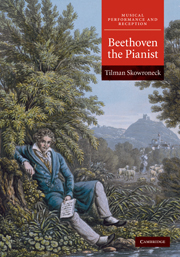Book contents
- Frontmatter
- Contents
- Acknowledgments
- Abbreviations and conventions
- Introduction
- PART I BEETHOVEN, HIS PLAYING, AND HIS INSTRUMENTS
- PART II SOUND IDEAL AND PERFORMANCE
- Introduction
- 5 The builder's influence
- 6 The player's influence
- PART III SOUND IDEAL, NOTATION, AND STYLISTIC CHANGE
- Epilog
- Bibliography
- Index
6 - The player's influence
from PART II - SOUND IDEAL AND PERFORMANCE
Published online by Cambridge University Press: 06 July 2010
- Frontmatter
- Contents
- Acknowledgments
- Abbreviations and conventions
- Introduction
- PART I BEETHOVEN, HIS PLAYING, AND HIS INSTRUMENTS
- PART II SOUND IDEAL AND PERFORMANCE
- Introduction
- 5 The builder's influence
- 6 The player's influence
- PART III SOUND IDEAL, NOTATION, AND STYLISTIC CHANGE
- Epilog
- Bibliography
- Index
Summary
REPORTS ABOUT BEETHOVEN'S PLAYING
The preceding excursion into practical issues has shown how the fortepiano can be used in modern Beethoven performance. This provides an opening for understanding the character of Beethoven's dealings with his instruments as a matter of musical practice instead of a mere struggle. On a personal level, however, this question needs further investigation. Most of the time, Beethoven was struggling with various aspects of his life. One might think that piano playing was a part of this pattern, even if his fame among his contemporaries was undeniably based on his exceptional musicianship and not, for instance, on his endless quibbles with friends, servants, and editors, on his imagined or real financial worries, or on his complex relationship with women. Piano playing was absolutely central for Beethoven during his early life. Even in one of the famous letters in which he announced his upcoming deafness, he defiantly stated that he had “substantially perfected” his piano playing. In the spring of 1802 (a year later), crisis apparently subdued his ambitions for a while; Griesinger wrote: “In the future, Beethoven wants to write only a little for the Klavier, but more polyphonic [music].” But on 18 October of the same year 1802, a week after writing the final version of the “Heiligenstadt Testament,” Beethoven proudly announced the variations Op. 34 and 35 to Breitkopf & Härtel, which were written in a “truly completely new manner.”
- Type
- Chapter
- Information
- Beethoven the Pianist , pp. 142 - 168Publisher: Cambridge University PressPrint publication year: 2010



